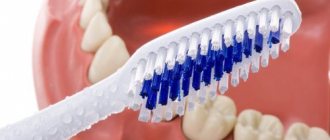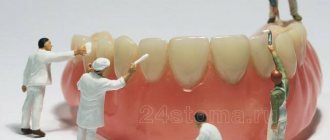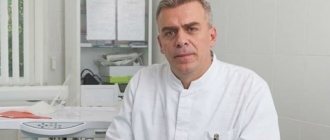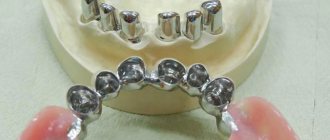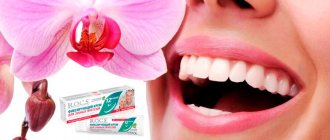- Complete removable dentures in Moscow
- Indications for use
- Types of removable dentures in complete absence of teeth
- Plate dentures for the entire jaw
- Removable dentures made of soft plastic
- Acrylic dentures for all teeth
- Removable nylon dentures
- Complete removable silicone dentures
- Clasp dentures for the entire jaw
- Pros and cons of complete dentures
- Preparation for prosthetics
- Manufacturing of complete removable dentures
- Fixation
- Care of complete dentures
- Complete removable dentures price
If we look at official statistics, almost half of the residents of our country by the age of 65 are faced with the problem of complete loss of teeth.
In medical practice, this phenomenon is called adentia. This situation should not be ignored, since edentia is not just an aesthetic defect that can cause psychological discomfort in the patient and affect self-esteem. Losing teeth is dangerous because it triggers a series of more serious health problems: the process of grinding food worsens, which leads to dysfunction of the digestive organs, impairs intestinal function, and as a result, the functioning of all internal organs is disrupted. The most progressive methods of restoring lost teeth are prosthetics on implants or the use of removable structures. Despite all the visible advantages of implantation, this method also has significant disadvantages. It may not be suitable for patients because it requires surgery, which may be contraindicated. And the second significant point is the high cost of all manipulations. An alternative, universal and suitable method of prosthetics for completely edentulous patients is the production and installation of removable orthopedic dental structures.
Removable dentures are distinguished by the fact that they can be removed and put on independently, at any time, without the involvement of specialists. There are two types of these structures:
- partially removable dentures;
- complete removable dentures.
Indications for use
As a rule, complete removable dentures are indicated for defects in a number of teeth, such as complete loss of chewing teeth. In addition, the pathological condition of the periodontium may be an indication. Severe periodontitis requires the installation of such structures; this will be the best solution for patients with this disease. The choice of the type of prosthesis depends on the specific case; the decision is made by the doctor together with the patient, based on a thorough examination of the oral cavity.
Photos before and after
InformationAge, diagnosis, treatment methodMale, 47 years old
Diagnosis: partial edentia
Treatment: All on 4 dental prosthetics in the upper and lower jaws, with immediate loading.
are presented “before” and “after” prosthetics .
Woman, 45 years old
Diagnosis: partial loss of teeth
Treatment: All-on-4 implantation of the upper and lower jaws, followed by immediate loading.
All on 4 prosthetics: photos “ before” and “after” the procedure.
Woman, 64 years old
Diagnosis: partial edentia
Treatment: prosthetics according to the All on 4 protocol for the lower and upper jaws, followed by loading.
are presented “before” and “after” prosthetics .
Male, 53 years old
Diagnosis: partial edentia
Dental prosthetics: in the photo, the All on 4 method of the upper and lower jaws, with immediate loading.
are presented “before” and “after” prosthetics .
Female, age 45 years.
Diagnosis: partial loss of teeth
Treatment: All on 4 upper and lower jaws, with immediate loading.
are presented “before” and “after” prosthetics .
Male, age 62 years.
Diagnosis: partial edentia
Treatment: one-stage dental prosthetics (pictured) All on 4 upper and lower jaws, with immediate load on the dentures.
are presented “before” and “after” prosthetics .
Male, age 61 years.
Diagnosis: partial edentia, crowded teeth
Treatment: All on 4 upper and lower jaws, with immediate loading.
are presented “before” and “after” prosthetics .
Female, age 59 years.
Diagnosis: partial absence of teeth, periodontitis
Dental prosthetics: All on 4 upper and lower jaws, with immediate loading.
are presented “before” and “after” prosthetics .
Types of removable dentures in complete absence of teeth
If there are no teeth left, the choice of design is significantly limited. Modern medicine offers the installation of prostheses on implants - this is the most reliable and most aesthetic method, but it is not available to everyone due to its high cost and indications. In this case, plate dentures remain - they are suitable for people of any age, if there are no allergic manifestations to the material used to create them. In the absence of teeth, all structures are similar in structure, but can be made of different materials. Let's decide what the pros and cons of different options are.
Plate dentures
Plate dentures, as the name implies, are a plate of different sizes. It acts as the basis of the structure, its basis. Fixing elements and artificial teeth are attached to it. Previously, such dentures were made exclusively from hard materials, but today dental technicians have a wider choice. This allows you to select products individually for patients, based on their needs and financial capabilities. But here it is necessary to remember that the material affects not only the comfort of wearing a denture, but also its service life.
Soft plastic dentures
Thus, acrylic products are considered the most durable. But since they are not always comfortable to wear, the formula of the material has been refined and improved. Complete removable dentures made of soft plastic were born. They are a combination of acrylic with the addition of additional components (for example, diamond chips). Their service life is very impressive, but due to their more plastic structure, they do not injure the gums, do not rub, and provide a tight fit.
Acrylic dentures
This type of prosthesis is the most popular - it is characterized by low price, aesthetics and ease of use. It consists of a base that covers the alveolar process and the body of the jaw, and artificial teeth attached to it. Before installing such a prosthesis, as in other cases, the oral cavity is first prepared for prosthetics, loose teeth are removed and the mucous membrane is treated, and then an impression of the jaws is made. Based on the impression, a primary model is created in the laboratory, which is adjusted and corrected after fitting. Acrylic or plastic prosthesis has the following advantages:
- an affordable way to completely restore teeth;
- ease of use;
- durability (7-9 years with proper care);
- uniform distribution of chewing load;
- quick adaptation period;
- lightness of the material, comfort of use;
- aesthetics and the ability to create a prosthesis that perfectly matches the color of natural gums;
- possibility of repair and correction;
- quick installation.
However, in order to decide which prosthesis is best to choose, you should know not only the advantages, but also the disadvantages of each type of design. For acrylic dentures, this is the possibility of an allergic reaction to the material, trauma to soft tissues during use, bad breath (acrylic is a porous material, bacteria can multiply in it), partial loss of taste, increased gag reflex, temporary impairment of diction and frequent need for correction. Most of these negative effects go away as you get used to the prosthesis, but some you have to put up with. To complete the adaptation period as quickly as possible, do not remove the denture at night.
Nylon dentures
The products are made from pink nylon, which is elastic and durable. They are similar to plate acrylic dentures, but differ from them in some parameters. This design perfectly imitates the gum and part of the alveolar process, it holds well and is suitable for sports enthusiasts. Such dentures are not removed at night even after the end of the adjustment period. A nylon prosthesis has the following advantages:
- hypoallergenic;
- high aesthetics;
- reliable fixation;
- low porosity, and, as a result, the absence of bad breath even after long-term use;
- flexibility, elasticity, comfortable use;
- durability (about 5 years);
- rare percentage of breakdowns.
The disadvantages of this type include the need for care of the prosthesis with the help of special means, the inability to repair in case of breakage, possible bone atrophy and mucosal injuries with prolonged use, uneven distribution of the chewing load (the flexible frame prevents this), the need for frequent correction and relatively high price.
In case of complete absence of teeth, implants are used to better fix the structure, and a metal arch is often used, which enhances the strength of the base. Thus, nyl dentures resemble dentures with a metal base and become even more durable.
Silicone prostheses
They are similar to nylon, but very different from them. Silicone is translucent; artificial – most often plastic – teeth are attached to a base made of it. Silicone dentures, as a rule, are used as temporary ones, because large gaps form between the teeth over time, and the service life of the structure is no more than two years, and it is rarely used for complete dentures. Their advantages:
- natural appearance;
- no allergic reaction;
- lightness and compactness;
- good fixation;
- softness of the material.
With prolonged use of the structure, atrophy of the alveolar bone and subsidence of the gums are possible, which is its significant drawback. In addition, they provide poor distribution of the chewing load and are difficult to maintain.
Clasp dentures
Clasp-type structures are practically not used in cases of complete edentia, since for strong fixation it will be necessary to create supporting surfaces. This requires additional time and financial expenses.
Why is implant-supported prosthesis considered the best solution?
I.
The dental implant method allows you to restore lost teeth using single crowns, bridges and full dentures supported by implants. Such a prosthesis, even in the absence of all teeth, completely restores chewing function.
II.
The implant completely replaces the root of a natural tooth: it receives the load from the crown and distributes it to the bone tissue, so that it does not undergo atrophy. Simply put, with the help of dental implants, the doctor restores the natural function of chewing to the fullest extent possible. Feedback from patients about implantation, especially from those who have previously used prostheses of other designs, will be positive in the vast majority of cases.
III.
The service life of an intraosseous dental implant (if its installation was carried out efficiently) is practically unlimited. We see patients who had implants installed more than 30 years ago. Particular attention should be paid to self-discipline and compliance with all rules of oral hygiene. The patient must understand that the presence of implants increases the requirements for daily hygiene (using not only a toothbrush, but also an irrigator) and implies regular (2 times a year) professional oral hygiene. Thus, the long-term functioning of implants is not only the competent work of the doctor, but also the responsible attitude of the patient himself to his health.
Pros and cons of complete dentures
Such designs are very popular; they have many advantages, including:
- Strength and elasticity . Prostheses are comfortable to wear, suitable for patients of all ages and safe. They are made according to an individual impression.
- High aesthetics . It is possible to choose the shape and color of teeth and gums as close as possible to natural ones. All this is selected on an individual basis.
- Easy to care for . Such structures are easy to care for; sometimes you just need to rinse them in running water.
The disadvantages include the following features:
- relatively long adaptation period;
- insufficiently stable fastening;
- feeling of discomfort when laughing, coughing or eating;
- not very long service life;
- food restrictions;
- violation of speech functions;
- the need for preventive regular examinations by a doctor.
Rules for caring for dentures
dentures while you sleep . The gums and mucous membrane need rest at least 5 hours a day. Otherwise, overload of the dentofacial apparatus is possible. Also, removing the structure will protect it from breakage. A person does not control himself while sleeping, so accidental pressure can damage the prosthesis.
The storage conditions of the removable system depend on the material of manufacture. Dentures made of nylon and Acry-Free plastic do not deform, so they can be stored in a container or in a damp towel or napkin. Some products are destroyed without moisture, so they require special conditions.
General storage rules for all structures:
- After each meal it is necessary to clean and rinse the denture;
- the structure should be regularly cleaned of any remaining fixing cream;
- for systems that are stored in liquid, use clean drinking or boiled water, a special solution;
- if there are metal clasps, the structure cannot be immersed in chlorinated water;
- The storage container must be free so that the denture can be easily lowered and removed.
It is necessary to adhere to the above rules at all times, regardless of the place where the person is. Any deviation from the recommendations may harm the base, which will subsequently lead to deformation of the prosthesis.
Manufacturers of dental structures produce special antiseptic liquids for storing removable systems. They are much better than ordinary water, as they disinfect the surface and protect the prosthesis from destruction. The following solutions are popular in domestic pharmacies: Ortosol -Dent and Curaprox Weekly.
Before each use, dentists recommend inspecting the structure for cracks and other damage. If they are present, the prosthesis cannot be worn; you must contact your doctor to replace the system.
In addition to standard hygiene procedures, cleaning is carried out once a week using special products (often these are effervescent tablets that dissolve plaque). They disinfect and eliminate unpleasant odors. Every six months you should visit the dentist to check the oral cavity, the condition of neighboring teeth and mucous membranes.
Preparation for prosthetics
An important role in the manufacture of high-quality, comfortable designs is played by preparing the patient for prosthetics. The doctor conducts a detailed examination of the oral cavity, identifies individual structural features of the maxillofacial apparatus, and determines the characteristic features of the jaws. At this stage, the material for creating the future structure, the optimal shape, size and color of artificial teeth are selected.
Individual spoons are used. The composition of the mass for impressions is also selected personally. Based on the casts, a model of the jaws is made.
The finished product is made from wax or plaster models. This is quite painstaking work and is carried out using special equipment. In this case, it is important to clearly maintain the distance between the teeth, the depth of their fixation, inclination and many other parameters.
When trying on dentures, the dentist identifies possible nuances that prevent a tight fit. All comments are sent to the laboratory, where a dental technician adjusts the design.
Manufacturing of complete removable dentures
The manufacturing process of both acrylic and nylon removable dentures occurs in several stages: taking impressions of the gums, casting a plate, welding teeth to it, and fitting the dentures to the patient’s jaws.
Acrylic dentures are produced by injection molding, and nylon ones are produced by hot injection under pressure. The latter method requires expensive modern equipment and qualified specialists who can work with such equipment. This has an impact on cost, and therefore nylon dentures are much more expensive than acrylic ones.
Care and storage
Dentures must be periodically removed from the mouth and cleaned. It's great if you do this every time after eating, but if this is not possible, you can rinse them in the morning and evening. Full dentures can be left in your mouth overnight, but it is best to remove them to give your gums a rest. In this case, before putting it in a special box, you need to thoroughly clean the prosthesis - rinse with boiled water, treat with an antiseptic solution or brush. It is recommended to have it professionally cleaned twice a year.
There is an opinion that the prosthesis should be stored in water or in a special solution. This is not so - a similar method was suitable for rubber prostheses, but modern technologies have made it possible to move away from it. Now it is enough to wrap the prosthesis in a cotton cloth and put it in a special box, where it will be protected from the sun, mechanical damage, heat and chemical influences.
Fixation methods
Removable dentures are secured in four ways: with clasps-hooks, clasps (attachments), on a beam and using the telescopic method. Let's look at each method separately:
- Hook clasps are especially relevant for clasp dentures. With the correct placement of the clasps, with the help of our clinic’s specialists, you can securely secure your denture in your mouth. The prosthetic structure itself contains two or more clasps, i.e. a whole system. With their help, false teeth will not only hold on well, but also be easily removed without the help of a doctor, that is, on your own.
- Micro-locks (attachments) are located simultaneously in the prosthesis itself and on the tooth. This allows you to secure removable dentures so that they do not pop out during eating, talking, hygiene procedures, etc. High aesthetic indicators are achieved by the fact that the clasps are not visible in the mouth and they do not fall into the smile line. In terms of price, such a system will be somewhat more expensive, but the costs are fully justified.
- The beam method involves attaching a prosthesis to a metal wire. It is attached to the remaining teeth, which are strengthened with crowns. The system consists of a removable and non-removable part, where the removable part ideally follows the matrix of its fastener, which gives comfort when wearing and removing the beam structure.
- Telescopic crowns, where special caps are fixed on the tooth, to which the prosthesis itself is attached. Very reliable fixation and the ability to easily remove and put on the system have made this method very popular, but it requires your own teeth that will not wobble.
Cost of complete removable dentures
| Name | Price from |
| Consultation with an orthopedic doctor | 500 rub. |
| Cost of complete removable dentures for both jaws | 60,000 rub. |
The cost of services is determined individually for each patient, since the individual characteristics of the patient’s oral cavity play a key role in the manufacture of structures. Factors such as the anatomical structure of the maxillofacial apparatus, the chosen type of structure, the material of its manufacture and methods of fixation, the shape and color of artificial teeth are taken into account.
Denta Labor dental laboratory produces complete removable dentures of excellent quality. Our laboratory has created all the conditions to produce high-quality prostheses with a long service life. You can check prices for removable dentures by phone 8 (495) 162-08-25.
Promotion! When paying in advance the full cost of making the prosthesis, the cost is reduced by 2000.
Choosing a clinic for prosthetics
Choosing a doctor for removable prosthetics is not an easy task. In this case, the specialist will have to take into account a lot of characteristics of the patient’s body and his oral cavity. Therefore, it is important to trust a true professional to install removable dentures.
It is the doctor you should look for for any prosthetics, and in which clinic he works is not so important.
Internet resources can also help you choose a specialist or clinic for installing prostheses. In most cities in Russia and Ukraine there are forums where reviews of dentists from various medical centers, clinics or dental offices are published.
Also, the prosthetics hotline smile-at-once.ru will help many people to choose real professionals in the field of dentistry. This site was created thanks to the Dental Association and is registered by the Ministry of Justice. This hotline is not a commercial project. In this case, you can go to the website or call the phone number provided and get a free consultation at several clinics. Thanks to this program, you can also use installments or a loan when paying for prosthetic services.
There is no need to be afraid of removable dentures. To successfully use such structures, there must be a “consensus” of the professionalism of the prosthetist, the correctly selected removable structure and the patient’s desire to learn to live with dentures. It is quite possible to live a full and quality life with dentures at any age. At the same time, people around them are often completely unaware of the presence of a prosthesis in a particular person. Take care of your teeth!
Sources used:
- Naomi Yamamoto, Masamitsu Oshima, Chie Tanaka, Miho Ogawa, Kei Nakajima, Kentaro Ishida, Keiji Moriyama & Takashi Tsuji, “Functional tooth restoration utilising split germs through re-regionalisation of the tooth-forming field”, Scientific Reports
- “Cosmetic dentistry is not a recognized specialty.” The Journal of the Michigan Dental Association.
- “Removable dentures: a textbook” (Mironova M.L.)
